
Treatise on Synchronous Existence, via
the presence of the contrasted observation, by means of assembly of
Insānia Tree and Four Spiritual Birds
Ibn Arabi
Discussion Join
Contents:
Shajara Kulliya or Insan Kulli
Discourse of Warqā' (Green) Ring Dove
(Mutawwaq)
Discourse of the Regal Eagle
Discourse of The Alien 'Anqā'
Discourse of the Pitch-Black Raven
Some References from Ibn Arabi's Works
Translation by Jaffray:
http://www.aic.ac/en/books/0953451399%20Universal%20Tree.pdf
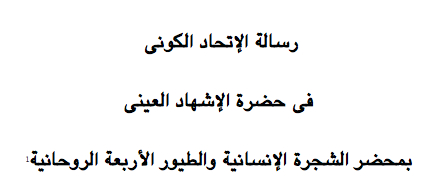
(Pointing) Towards the Three-ness and Two-ness (spiritual states),
while (their) administrator/governor (is Hu or Allah) Lord of
the
Being-Three and Being-Two (being in such states), all the while
pointing at Him/Hu from
within the Al-Mathāni (Surah Al-Fatiha)…
(Pointing) Towards the Three-ness and
Two-ness (spiritual states): Ibn Arabi is pointing at the two
discernible states of human spirituality saying that their Lord who
administrates and organizes them is no one other than Allah who has
been pointed at in the Surah Al-Fatiha of Qur'an. Therefore those who
experience the Two-ness spiritual state should not be mislead that they
are coming into contact with spirits or demons or other beings or
psychological anomalies, rather they are in communication with Allah in
a modality that there is the person and no one else.
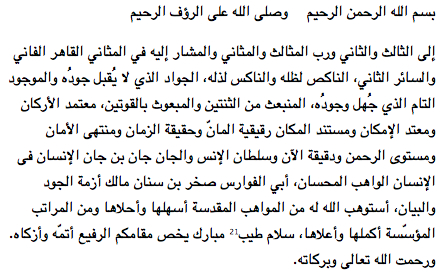
There are modalities and states to the Divine Presence and experience
and feeling the Divine Presence, two of which are:
Three-ness spiritual state:
This is when there are three agents involved in the experience of the
Divine Presence:
1. Servant invoking Allah
2. Allah
3. All else i.e. the people and the world around us
The total adds up to three entities.
Two-ness spiritual state: This
when there are only two agents involved in the experience of the Divine
Presence:
1. Servant invoking Allah
2. Allah
And no one else!
The former, i.e. the Three-ness state, is experienced by all of
us and it is an 'Ām (General Public) state enjoyed by all.
The latter, i.e. the Two-ness state, is experience solely by few
exclusive servants or Khās (Khawās, pl.); and it is based upon a Hadith
(Prophetic Narration):
"For me (Muhammad) there is an instant (or period of time) (so
exclusive) that even an angel close to Allah or a sent
prophet cannot
afford to catch-up/share/fit/afford (that moment)".
In Risala Qushairi another version is found: For me (Muhammad) there is
an instant (or period of time) (so exclusive) that no one other my Lord
is in it (during this moment no one but Allah is
present).
Two-ness state is coined as Ithnainiyat.
Remark: Awkward creative words like Three-ness and
Two-ness are used to avoid intermingling with any other concepts of
duality or trinity. Some Juhhal (Intensely Ignorant) Arab accused
Sheikh Ibn Arabi of subscribing to the Christian Trinity and therefore
accused him of heresy.
الجامع الصغير. - لجلال الدين
السيوطي
المجلد الرابع >> [تتمة باب حرف
الراء]
4377- رأيت ربي عز وجل [وزاد في رواية
الدارقطني: "في أحسن صورة"]ـ
["رأيت ربي عز وجل": بالمشاهدة العينية،
التي لم يحتمل الكليم (موسى عليه السلام) أدنى شيء منها، أو القلبية،
بمعنى التجلي التام، فقد روي عنه عليه السلام: لي مع الله وقت لا يسعني فيه ملك
مقرب ولا نبي مرسل (وقول المناوي "روي" يشير إلى ضعف الحديث).
والأرجح أن الله جمع له بين الرؤية البصرية والجنانية، ولا يعارضه قول
الله لكليمه "لن تراني"، وإن كان حرف "لن" لتأبيد النفي: إذ لا يلزم من
نفيها عن موسى عليه السلام نفيها عن محمد صلى الله عليه وسلم، والله
سبحانه حي موجود، فلا يمتنع رؤيته عقلا، وحاسية العين غير ركن (أي غير
ضروري) للرؤية، ولولا حجب النفس والهوى لرأت العين في الدنيا ما يراه
القلب، وعكسه.
{فائدة} قال المؤلف (السيوطي): من
خصائصه رؤيته للباري تعالى مرتين، وركوب البراق في أحد القولين.
{تنبيه} هذا الحديث رواه الدارقطني
وغيره عن أنس، وزاد فيه: "في أحسن صورة". قال المؤلف: وهذا، إن حمل على
رؤية المنام فلا إشكال، أو اليقظة فقد سئل عنه الكمال بن الهمام فأجاب أن
هذا حجاب الصورة. انتهى.]ـ
التخريج (مفصلا): أحمد في مسنده عن ابن
عباس [ورواه الدارقطني وغيره عن أنس]ـ
تصحيح السيوطي: صحيح
تصحيح المناوي: قال الهيثمي: رجاله رجال
الصحيح. ومن ثمة رمز المصنف (السيوطي) لصحته.
كشف الخفاء، -
للإمام العجلوني
حرف اللام.
2159 - لي مع الله وقت لا يسعني فيه ملك مقرب ولا نبي مرسل.
تذكره الصوفية كثيرا، وهو في رسالة القشيري بلفظ لي وقت لا يسعني فيه غير ربي،
ويقرب منه ما رواه الترمذي في شمائله وابن راهويه في مسنده عن علي في حديث
كان صلى الله عليه وسلم إذا أتى منزله جزأ دخوله ثلاثة أجزاء جزءا لله
وجزءا لأهله وجزءا لنفسه ثم جزأ جزأه بينه وبين الناس كذا في اللآلئ،
وزاد فيها ورواه الخطيب بسند قال فيه الحافظ الدمياطي أنه على رسم الصحيح،
وقال القاري بعد إيراده الحديث قلت ويؤخذ منه أنه أراد بالملك المقرب
جبريل وبالنبي المرسل أخاه الخليل انتهى فليتأمل،
ثم قال القاري وفيه إيماء إلى مقام الاستغراق باللقاء المعبر عنه بالسكر
والمحو والفناء انتهى.
Jalal: This meaning can be felt by investigating the Divine
Name/Attribute of Al-Qayyum i.e.
every creature only needs Allah to
subsist its existence, and therefore
can have modality of existence that there is only itself and Allah and
no one else.
all the while pointing at IT/Him/Hu
from within the Al-Mathāni (Surah Al-Fatiha):
Q: Why Surah Al-Fatiha was
mentioned in regards to the Two-ness and Three-ness?
A: The 'second segment' of
Fatiha in the blow Hadith clearly indicates the short-lived state of
Two-ness while reading the 5th verse of Fatiha:
Allah has
said: "I have split the Salāt (Daily mandatory Dhikr/worship)
into
two
parts
between
Myself
and
My slave":
(First Segment, Allah’s
portion)
When the slave says: “(2) Praise (be) to Allah, the
Cherisher and Sustainer of the worlds”, Allah replies: My slave has
praised me.
(For full discussion see Al-Hamd (Praise to
Allah))
When the slave says: “(3) Most Beneficent, Most Merciful”, Allah
replies: "I am being extolled by My slave".
When the slave says: “(4) Master of the Day of Judgment.”, Allah
replies:" My slave has glorified Me".
(Second segment, shared between Allah and the
slave)
When the slave says: “(5) YOU we
worship, and (from) YOU we seek (aid and help)”, Allah replies: "This is between Myself and My
slave and for My slave whatever he asks for".
(Segment solely for the slave)
When the slave says: “(6) Show us the straight way, (7) The way of
those on whom Thou hast bestowed Thy Grace, those whose (portion) is
not wrath, and who go not astray.”, Allah replies:
This is for My slave and for My slave be whatever he asked for.
ولنا حديث أبي هريرة
قال: سمعت النبي عليه السلام يقول: " قال الله تعالى قسمت الصلاة ـ أي
الفاتحة ـ بيني وبين عبدي نصفين ولعبدي ما سأل فإذا قال العبد { ٱلْحَمْدُ
للَّهِ رَبّ ٱلْعَـٰلَمِينَ } قال الله تعالى: حمدني عبدي. وإذا قال {
ٱلرَّحْمَـٰنِ ٱلرَّحِيمِ } قال الله تعالى: أثنى عليّ عبدي. وإذا قال {
مَـٰلِكِ يَوْمِ ٱلدّينِ } قال: مجدني عبدي. وإذا قال { إِيَّاكَ نَعْبُدُ
وَإِيَّاكَ نَسْتَعِينُ } قال: هذا بيني وبين عبدي ولعبدي ما سأل. فإذا
قال { ٱهْدِنَا ٱلصّرَاطَ ٱلْمُسْتَقِيمَ * صِرَاطَ ٱلَّذِينَ أَنْعَمْتَ
عَلَيْهِمْ غَيْرِ ٱلْمَغْضُوبِ عَلَيْهِمْ وَلاَ ٱلضَّالّينَ } قال: هذا
لعبدي ولعبدي ما سأل "
The said spiritual state of Two-ness is called Al-Ittihad according the
Sufi references compiled by Farhang-e Istlihat-e Irfani by Dr. Sajjadi.
The latter gives a reference from Misbah Al-'Uns of Qunawi which talks
about a modality of Divine Presence felt by the person which is free of
all else other than Allah and even
most of the corporeal attributes of
the person is not included. Therefore the English translation of
Synchronicity is best suited for this circumstance.
Q: What does then the title
Al-Ittihad Al-Kauni means?
A: Ibn Arabi is detailing a
modality of existence i.e. Al-Ittahid Al-Kauni, which the two realms of
Malakut (Spiritual
Realm) and Mulk (Corporeal
Realm) are synchronized.
In other words the person experiences happenings of this world
synchronized with spiritual entities of the other world, no longer the
person perceives two un-linked independent realms, indeed feels the two
discernible and partitioned realms are suddenly are synchronized in
spite of any physical linkage. Additionally the person feels very
little of this world and his personal attributes during this modality
of existence.
Reference to Ibn Arabi's Fusus
According to the Adam's Seal i.e. the beginning of Ibn Arabi's Fusus
the universe is a mirror, and using this concept we can render the
Three-ness and Two-ness states under a different light:
Three-ness: When there is an object, object's reflection and a mirror.
This is the world we are used to.
Two-ness: When there is an object and an object's reflection but there
is no mirror! This is a little experienced form of existence these
days.
In the back of the collection of Ibn Arabi's Rislalaat (Treatise) the
following short guide to the words and their spiritual meaning is
found, and one can easily deduce the English translation of
Synchronicity from Ibn Arabi's definitions:
Book of Sufi Terminologies
Ibn Arabi
Al-Ittihad: Tasyir (Transformation, Happenings) of two
discernible/independent entities as if one (acting as one entity), and
they are (considered to be) two entities only due to (the process of)
counting, i.e. that is (being one in) Hala (being in the same temporary
state)
كتاب اصطلاح الصوفية
ابن عربي
الإتحاد : تصيير الذاتين واحدة و لا
يكون إلا في العدد و هو حال
Shajara Kulliya or Insan Kulli
"I am The Omnipresent/Ubiquitous/Universal Tree ... with roots and
branches..."
Qidam is the seed of all things. Qidam is the infinite past, or realm
of actualities free of all potentialities and probabilities. Everything
in Qidam is actual i.e. has no potentiality to become, it just is. And
it is so actualized and certain that it has the feel of the past, since
all things in past are actual and exact since they already happened.
There are no potentialities in the past, it either happened or not.
Our universe, here, is a universe of potentialities. Flip a coin, it is
either Head (H) or Tail (T). No event has any certainty for its outcome.
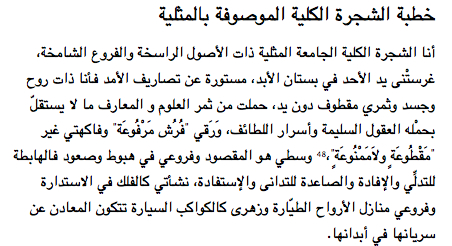
Q: How did the universe of Qidam (Infinite Past) free of all
potentialities, link to our fully potential-probabilistic present
universe?
If you could imagine flipping a coin in Qidam there are no discernible
outcomes. Head (H) and Tail (T) are one and the same i.e. had you
flipped a coin you would have got both H and T at the same time since
you could not tell them apart.
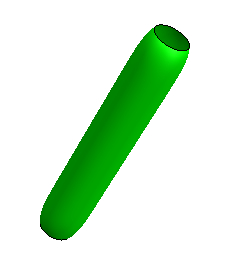
As you move away from Qidam i.e. become closer to the present moment,
little by little two outcomes become almost discernible. If you flip a
coin here then there are two outcomes, H and T and both happen at the
same time.
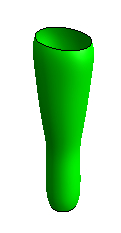
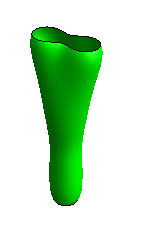
Move more and more towards this present moment and H and T become more
discernible and yet one and the same thing.
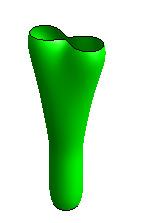
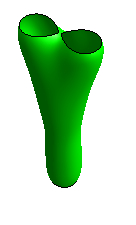
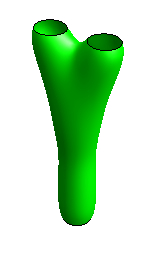
It arrives a time, quite close to the present moment, when suddenly
there are two distinct outcomes to the flipping of the coin i.e. H and
T and there are now two different entities as the outcome of the
flipping.
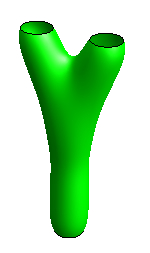
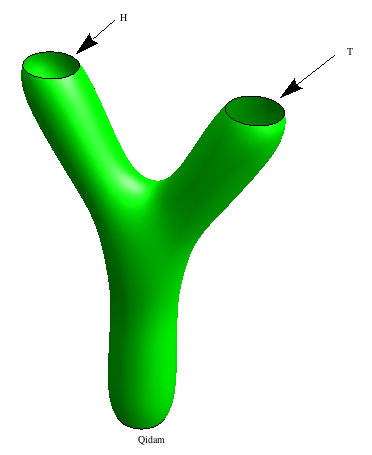
Imagine all the events in the cosmos going through the same process all
those branchings assemble to a tree:
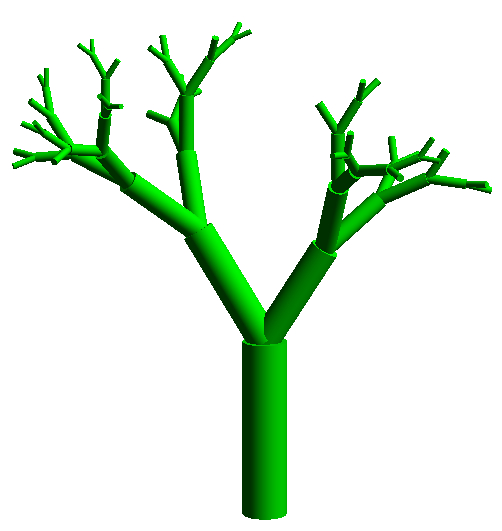
And this tree, of course, is Omnipresent or Universal.
At the end of the book Ibn Arabi calls this Omnipresent Tree another
name Insan Al-Kulli which can have two meanings:
1. Omnipresent Human Being
2. Omnipresent Eye
Omnipresent Human Being
All potentialities in our universe is caused by the appearance of human
beings i.e. exit of man from Qidam (Infinite Past) into the present
moment. It is the nature of the human essence that causes all the
potentialities in the universe. Thus the said tree is really the
structure of human presence in this world, connecting Qidam to present
moment.
Omnipresent Eye
Our vision and for that matter all our senses operate in the past i.e.
immediate past. What you see of the words in this sentence appeared few
micro seconds ago to your eyes but it takes a bit of time to transfer
and process in the brain to understand. Therefore your eyes are always
viewing the past! Consequently you are looking backwards along the
branches towards the trunk/root of the said tree whenever you look! So
this tree is really a structure attached to your eye, an extension of
your biological eyes.
Discourse of Warqā' (Green) Ring Dove
(Mutawwaq)
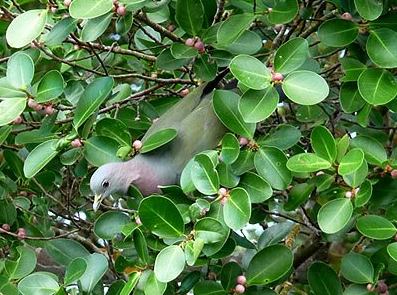
And when she (Green Ring Dove) heard the words of the Omnipresent Tree
and what came to it (dove or tree?) from the gnostics of sempiternity,
let out a loud call/chant midst the meadows of her (Tree's) sanctities
to CLEARLY announce herself (the dove).
Jalal: The said Ring Dove is green and the Tree is also green and as
such the green dove is camouflaged! She needs to call out loud to
attract attention to herself. "meadows of tree's sanctities" indicates
a realm where there is tree and nothing else. In other words Ring Dove
is trying to become something other than the tree and yet she is stuck
in the boundary of sanctity of tree-ness and cannot therefore become
(to exist as a separate entity).
She (Green Ring Dove) said: When Allah willed to
make my existence to
become and to contrast my observations (discern me from the tree and
all else so I can be observed) and to collar me with the collar of
Bahā' (Immense unbearable Beauty) and to place me to reside me in
Sidra-t Al-Muntahā, therefore (for that purpose) called upon His Eagle
and assured him he would be secure from any punishment while the Eagle
was the His door's courtyard, therefore the Eagle replied obediently
(Affirmative): " I heard Your call".
Jalal: Green Ring Dove completely concealed within the verdant
Omnipresent Tree and has no way of becoming something in and of herself
until Allah
wills her to become another entity discernible from from
the Tree. For that to happen Ring Dove needs to contrast from the
vernal background of the Tree since she is herself green. So Allah
givers her Ta'ayyun (Contrast) because she could be an existence but
not contrasting enough from the Tree. And Allah wished one more thing
for her: to be collared! Animals are collared to be dragged and thus
subjugated to the will of their owner. In this case the Ring Dove is
collared and subjugated to immense beauty that no eye in cosmos has
capacity to endure to enjoy in full! Bahā' is used as the word for that
collar which is related to the letter Ba ('b' sound in Arabic) and the
first letter of Basmala (Bismillahi Al-Rahmani Al-Rahim) as the Divine
letter of ignition i.e. every object is objectified only by the
appearance and involvement of the letter Ba to commence to be.
Q: Why did Allah
give the Eagle the immunity from punishment?
A: Because Ring Dove is within the 'meadows of sanctities' of the Tree
and in order for the Eagle to help to become another entity all to
herself and away by Sidra-t Al-Muntahā he needs to violate the sanctity
of both Omnipresent Tree as well as the Sidra-t Al-Muntahā! These are
punishable crimes judged for the transgressors of the said trees. So
Allah tells
the Eagle not to worry he is give immunity.
Allah
continues telling the Eagle: "You are in an estranged realm since
you are in My close proximity (since there is nothing close to Allah
due to Taqdis (sanctification)) and I (Allah) am not of your kind and
for sure you are feeling lonely. However there is a delightful darling
(Qurrat Al-'Ain) within you (Eagle) make her emerge (become patent from
deep within you) by using the contrast of intimacy by keeping her
company and her conversations, for sure the intimate relationship of
any kind with Me (Allah) is impossible since I am mighty in power".
Eagle replies: How can I emerge anything from deep within me and my
abilities are abysmal and no authority or power (within my reach)?
Allah
replies: The prerequisite (for her emergence from deep with you)
is cooing and she will then appear and this (regular back and forth
cooing) is the method for Two-ness and union through being-Two.
Consequently (the Eagle) cooed and she (Green Ring Dove) emerged.
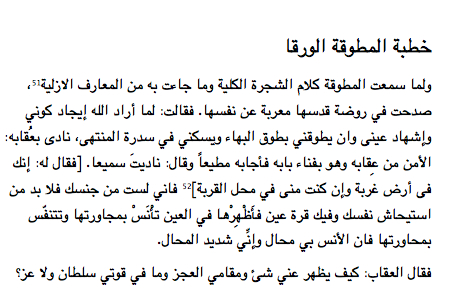
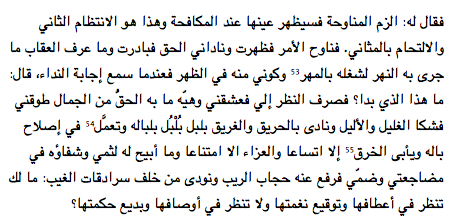
Cipher
Kitab Al-Istilah Al-Sufiyya
Ibn Arabi
Eagle: 'Aql Al-Awwal
(Primordial
Intellect) or Qalam (Primordial
Pen); gendered as male.
Al-Ittihad Al-Kauni
Ibn Arabi
Green Ring Dove: Al-Nafs
Al-Wāhida-t; gendered as female; singleton self/entity. See the word
used in Qur'an:
4:1 O mankind! reverence your Guardian-Lord, who created you from a Nafs Al-Wahida, created, of like
nature, his mate, and from them twain scattered (like seeds) countless
men and women;- reverence Allah, through
whom ye demand your mutual
(rights), and (reverence) the wombs (That bore you): for Allah ever
watches over you.
يَا
أَيُّهَا
النَّاسُ
اتَّقُوا
رَبَّكُمُ
الَّذِي
خَلَقَكُمْ
مِنْ نَفْسٍ
وَاحِدَةٍ وَخَلَقَ مِنْهَا زَوْجَهَا وَبَثَّ مِنْهُمَا رِجَالًا
كَثِيرًا وَنِسَاءً وَاتَّقُوا اللَّهَ الَّذِي تَسَاءَلُونَ بِهِ
وَالْأَرْحَامَ إِنَّ اللَّهَ كَانَ عَلَيْكُمْ رَقِيبًا
6:98 It is He Who hath produced you from a Nafs Al-Wahida: here is a place of
sojourn and a place of departure: We detail Our signs for people who
understand.
وَهُوَ
الَّذِي
أَنْشَأَكُمْ
مِنْ
نَفْسٍ
وَاحِدَةٍ
فَمُسْتَقَرٌّ
وَمُسْتَوْدَعٌ
قَدْ فَصَّلْنَا الْآَيَاتِ لِقَوْمٍ يَفْقَهُونَ
7:189 It is He Who created you from a Nafs
Al-Wahida, and made his mate of like nature, in order that he
might dwell with her (in love). When they are united, she bears a light
burden and carries it about (unnoticed). When she grows heavy, they
both pray to Allah
their Lord, (saying): "If Thou givest us a goodly
child, we vow we shall (ever) be grateful."
هُوَ
الَّذِي
خَلَقَكُمْ
مِنْ
نَفْسٍ
وَاحِدَةٍ
وَجَعَلَ
مِنْهَا زَوْجَهَا
لِيَسْكُنَ إِلَيْهَا فَلَمَّا تَغَشَّاهَا حَمَلَتْ حَمْلًا خَفِيفًا
فَمَرَّتْ بِهِ فَلَمَّا أَثْقَلَتْ دَعَوَا اللَّهَ رَبَّهُمَا لَئِنْ
آَتَيْتَنَا صَالِحًا لَنَكُونَنَّ مِنَ الشَّاكِرِينَ
31:28 And your creation or your resurrection is in no wise but as an Nafs Al-Wahida: for Allah is He Who
hears and sees (all things).
مَا
خَلْقُكُمْ
وَلَا
بَعْثُكُمْ
إِلَّا
كَنَفْسٍ
وَاحِدَةٍ
إِنَّ اللَّهَ
سَمِيعٌ بَصِيرٌ
39:6 He created you (all) from a Nafs
Al-Wahida: then created, of like nature, his mate; and he sent
down for you eight head of cattle in pairs: He makes you, in the wombs
of your mothers, in stages, one after another, in three veils of
darkness. such is Allah,
your Lord and Cherisher: to Him belongs (all)
dominion. There is no god but He: then how are ye turned away (from
your true Centre)?
خَلَقَكُمْ مِنْ نَفْسٍ وَاحِدَةٍ ثُمَّ جَعَلَ مِنْهَا زَوْجَهَا
وَأَنْزَلَ لَكُمْ مِنَ الْأَنْعَامِ ثَمَانِيَةَ أَزْوَاجٍ يَخْلُقُكُمْ
فِي بُطُونِ أُمَّهَاتِكُمْ خَلْقًا مِنْ بَعْدِ خَلْقٍ فِي ظُلُمَاتٍ
ثَلَاثٍ ذَلِكُمُ اللَّهُ رَبُّكُمْ لَهُ الْمُلْكُ لَا إِلَهَ إِلَّا
هُوَ فَأَنَّى تُصْرَفُونَ
Discourse of the Regal Eagle
And when the Eagle heard what Green Ring Dove had mentioned to him and
what she conveyed to him of indubitable knowledges, he then said:
(Green Ring Dove) has veracity in what had claimed and she has emerged
for you (pl.) of what she contains (of knowledge).
I said to him (Eagle): Fly through the atmosphere of your Bayān
(Rigour) and elucidate for us your nature. The throne of the
eagle shook and while he flapped his wings with joy:
I am the Eagle, for me most-high rank, the goodness, the most beautiful
resplendent light
I execute the affairs, orderly, in compliance with wisdom
From the shores of the corporeal realm, my power forbids (or forbidden
for me to enter this physical realm or the physical realm come close to
me)
I was non-being without any 'Ayn (Contrast to be seen), until Divine
Providence (graceful attention) brought forth my existence, (an
existence) with a beginning. And this was so due to IT lucently
manifested (Tajalli)
ITself
to ITself, consequently my existence was
prolonged by instrument of IT SEEING ITself.
consequently my existence was prolonged by instrument of IT SEEING
ITself: IT shone light upon ITself, So IT sees ITs own Divine Beauty,
and such process requires:
1. An Eye to see
2. Light to illuminate
3. Beauty to endue the seeing with Divine Gift of pleasure
From the leftover of 1-3 there was enough light and Eye to focus on a
contrast to see the Eagle (Eagle contrasted), and as long as this light
shines and this Eye sees the contrast ('Ayn) then
the Eagle prolongs to
be.
…
Fly through the atmosphere of your
Bayān (Rigour): The Regal Eagle is Al-'Aql Al-Awwal (Primordial
Intellect) as depicted in the Hadith (Prophetic Narration). The Aql is
spatial i.e. has attributes of space, as those of our brain and
thoughts. They, our minds and thoughts, have spaces within which they
do signals, computations, thoughts and imagination and so on. Therefore
the Eagle is told to fly i.e. move rapidly within the space of
Primordial Intellect. Each motions becomes or rigorously brings forth
knowledges or thoughts or rationalizations in most precise accurate
manner hence the word rigour. In other words, when a bird flies in the
atmosphere of this planet, it produces waves and eddies, sounds and
images as the result of its motility. This Eagle in place of waves and
sounds and images produces thoughts and knowledges and so on as the
result of his motility.
I was non-being without any 'Ayn
(Contrast to be seen): Some entities might not have existence
but can be SEEN, we all have experienced that, almost on daily basis
when scientists imagine some fact (yet to be observed) or the weather
man forecasts the future of the weather. Although the entity is not in
existence, yet it has an image that forms in our minds, forms by the
optical-like act of increasing its contrast so we can see it before it
even becoming. So the Eagle said he was so non-existence that even did
not have such an ocular image that could be contrasted and viewed.
(an existence) with a beginning:
There
are
some
forms
of
existence that have no beginning, there is no
knowledge that can explain how the entity started. But the Eagle
informs Ibn Arabi that he had a beginning. For example the Estranged
'Anqa' has no beginning, but Eagle does.
And I become ITs throne by (my)
Sarira-t (Divine Observatory): When the light shone and when the
Divine Eye saw the contrast that formed i.e. the Eagle, the Eagle
itself developed an eye of its own, this de novo eye sees the Divine
Knowledges and Divine Secrets like an observatory which is called Sirr
in Sufism e.g. Sarira-t is another version of the word Sirr. Therefore
people and things can use the Eagles new eye to see things about Allah
and feel an ocular form of Divine Presence without actually seeing
Allah and that is called the throne: Place a king is being exhibited to
honour and adore and fear.
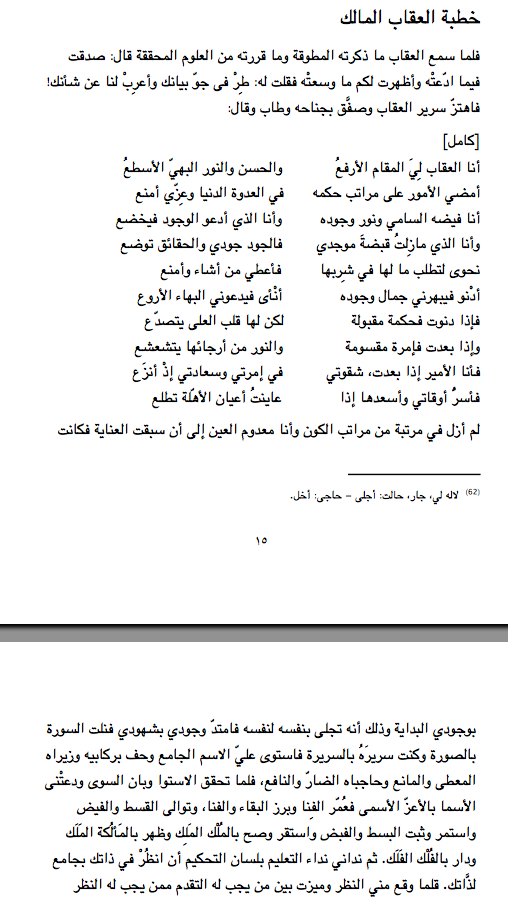
Discourse of The Alien 'Anqā'
And when the Eagle finished his words elucidating his rank,
'Anqā', stood (to be seen), elucidated the nature of her existence and
like a sun set at her boundary of greatness (disappeared into the
sunset).
She said: I am the 'Anqā' Mugharrib (Alien), my dwelling ceases not to
be in Mugharrab (Exiled), a middle place, on the banks of surrounding
sea.
Greatness has surrounded me from both sides (Spiritual Realm vs.
Corporeal Realm) and for my existence there has never be any contrast
(to be seen by any eyes).
All boundaries/limits are due to me (or end at me) and existence of all
things stops/ends at me. I am heard (or talked about) but not seen
(invisible), and I am not fictitious. I am the absent 'Anqā', my mother
the Green Ring Dove and my father the Regal Eagle and my child the
Pitch-Black Raven.
I am of the race of Light and Darknesses (I am made from elements of
light and darknesses). A place for both trust and suspicion. I have no
Qabiliyat (Receptivity)
for the Absolute Light and have cognizance of
any knowledge since I am (extremely) uncommon (no one can have any
cognizance of me since I am so acutely unusual).
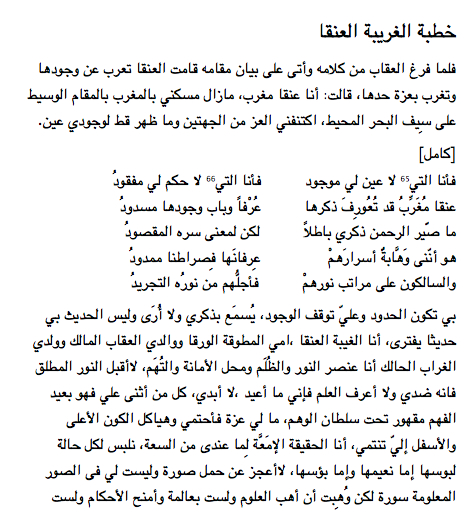
Lisan Al-Arab
Ibn Manzur
Anqa a large bird that is not eagle.
It is said (by the Arab): 'Anqā' Mugharrib i.e. there is no root for
the word (it is a word by itself without any derivation from any other
word, since most Arabic words are derivations from three-letter verbs
of the form fa'ala).
Jalal: Due this attribute the 'Anqā' Mugharrib has no beginning unlike
the Regal Eagle.
It is said: It is called 'Anqā' since the neck ('Unuq) is white like a
ring.
Al-Zajaj: 'Anqā' Mugharrib is a bird no one has seen. (Hence the
estranged uncommon comments in Ibn Arabi's text).
لسان العرب ابن منظور
يعني الشدَّة أَي من الحادي أَو من الجمل. ابن الأَعرابي: يقال منه لقيتُ
أُذُنَيْ عَناقٍ أَي داهية وأمراً شديداً. وجاء فلان يأُذني عنَاق إذا جاء
بالكذب الفاحش. ويقال: رجع فلان بالعَناق إذا رجع خائباً، يوضع العَناق
موضع الخيبة. والعنَاق: النجم الأَوسط من بنات نَعْش الكُبْرى:
والعَنْقاءُ: الداهية؛ قال: يَحْمِلْنَ عَنْقاء وعَنْقَفِيرا،
وأُمَّ خَشّافٍ وخَنْشَفِيرا،
والدَّلْوَ والدَّيْلَمَ والزَّفِيرَا
وكلهن دَواهِ، ونكرَّ عَنْقاء وعَنْقَفِيراً، وإنما هي العَنْقاء
والعَنْقَفِير، وقد يجوز أن تحذف منهما اللام وهما باقيان على
تعريفهما.والعَنْقاء: طائر ضخم ليس بالعُقاب، وقيل: العَنْقاءُ المُغْرِبُ
كلمة لا أَصل لها، يقال: إنها طائر عظيم لا ترى إلا في الدهور ثم كثر ذلك
حتى سموا الداهية عَنْقاء مُغْرِباً ومُغْرِبةً؛ قال: ولولا سليمانُ
الخليفةُ، حَـلَّـقَـتْ به، من يد الحَجّاج، عَنْقاءُ مُغْرِب
وقيل: سمِّيت عَنْقاء لأنه كان في عُنُقها بياض كالطوق، وقال كراع:
العَنْقاء فيما يزعمون طائر يكون عند مغرب الشمس، وقال الزجاج: العَنْقاءُ
المُغْرِبُ طائر لم يره أَحد، وقيل في قوله تعالى؛ طيراً أَبابِيلَ؛ هي
عَنْقاءُ مُغْرِبَة. أَبو عبيد؛ من أَمثال العرب طارت بهم العَنْقاءُ
المُغْرِبُ، ولم يفسره. قال ابن الكلبي: كان لأهل الرّس نبيٌّ يقال له
حنظلة بن صَفْوان، وكان بأَرضهم جبل يقال له دَمْخ، مصعده في السماء
مِيلٌ، فكان يَنْتابُهُ طائرة كأَعظم ما يكون، لها عنق طويل من أَحسن
الطير، فيها من كل لون، وكانت تقع مُنْقَضَّةً فكانت تنقضُّ على الطير
فتأْكلها، فجاعت وانْقَضَّت على صبيِّ فذهبت به، فسميت عَنْقاءَ مُغْرباً،
لأَنها تَغْرُب بكل ما أَخذته، ثم انْقَضَّت على جارية تَرعْرَعَت وضمتها
إلى جناحين لها صغيرين سوى جناحيها الكبيرين، ثم طارت بها، فشكوا ذلك إلى
نبيهم، فدعا عليها فسلط الله عليها آفةً فهلكت، فضربتها العرب مثلاً في
أَشْعارها، ويقال: أَلْوَتْ به العَنْقاءُ المُغْرِبُ، وطارت به العَنْقاء.
والعَنْقاء: العُقاب، وقيل: طائر لم يبق في أَيدي الناس من صفتها غير
اسمها.
والعَنْقاءُ: لقب رجل من العرب، واسمه ثعلبة بن عمرو. والعَنْقاءُ: اسم
مَلِكِ، والتأنيث عند الليث للفظ العَنْقاءِ. والتَّعانِيقُ: موضع؛ قال
زهير: صَحَا القلبُ عن سَلْمَى، وقد كاد لا يَسْلُو،وأَقْفَرَ، من
سَلْمَى، التَّعانِيقُ فالثِّقْلُ
Rabi'a Al-Abrar (The Spring of the
Pious)
By Al-Zumukhshari (Linguist of the
Arab 700 years back?)
From Ibn Abbas (child-companion of the Prophet):
Allah created
in the time of Moses peace be upon him a special bird,
her name Anqa', She had 4 wings in either side, and her face like a
human, and gave her many goodness and beauty, and Allah created for her
a male mate, and Allah inspired Moses that I have created a strange
couple of birds, and gave her provision amongst the wildlife of Holy
House of Jerusalem, and I made them company for you even as additional
blessings for the children of Israel and Allah made these birds
flourish.
And after Moses died they moved to Najd and Hijaz (around Saudi Arabia)
and they did not descent to hunt and dropped their offsprings until a
prophet called Khaled Ibn Sanaan appeared between the Jesus and
Muhammad's time. And they complained to this prophet (sorrowing for
absence of Moses) and the prophet asked Allah to make
them extinct and
they gradually disappeared.
ربيع الأبرار الزمخشري
عن ابن عباس: إن الله خلق في زمان موسى عليه السلام طائراً اسمها العنقاء،
لها أربعة أجنحة من كل جانب، وجهها كوجه الإنسان، وأعطاها من كل شيء حسن
قسطاً، وخلق لها ذكراً مثلها، وأوحى إليه أني خلقت طائرين عجيبين، وجعلت
رزقهما في الوحوش التي حول بيت المقدس، وآنستك بهما وجعلتهما زيادة فيما
فضلت به بني إسرائيل. فتناسلا وكثر نسلهما.
فلما توفي موسى عليه السلام انتقلت فوقعت بنجد والحجاز، فلم تزل تأكل
الوحوش وتخطف الصبيان إلى أن تنبأ خالد بن سنان العيسى بين عيسى ومحمد.
فشكوها إليه، فدعا الله تعالى فقطع نسلها وانقرضت.
Discourse of the Pitch-Black Raven
Then the Raven stood up (to be distinguished) and said: I am the
scaffold for lights (pl.) and the transporter of the place of Al-Asrar
(i.e. Divine Observatory) and the place of Al-Kaif (How-ness
qualitative) and the place of Al-Kam (How-much-ness quantitively) and
the instrument of joy and soffow, the leader of the followers, the
'sense' and the 'sensed' are for (from) me. Through me emerged the
material designs (blue-prints) and from on me (from me) stood the realm
of corporeal bodies.
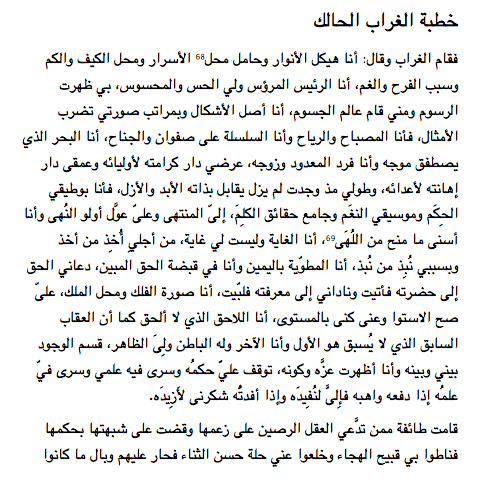
Some References from Ibn Arabi's Works
الفتوحات المكية
محيي الدين ابن عربي
وما السكينة قلنا ما تجده من الطمانينة عند تنزل الغيب بالحرف فان قلت وما
الحرف قلنا ما يخاطبك به الحق من العبارات مثل ما انزل القران على سبعة
أحرف والحرف صورة في السبحة السوداء فان قلت وما السبحة قلنا الهباء الذي
فتح فيه صور أجسام العالم المنفعل عن الزمردة الحضراء فان قلت وما الزمردة
الخضراء قلنا النفس المنبعثة عن الدرة البيضاء فان قلت وما الدرة البيضاء
قلنا العقل الأول صاحب علم السمسمة فان قلت وما السمسمة قلنا معرفة دقيقة
في غاية الخفاء تدق عن العبارة ولا تدرك بالأشارة مع كونها ثمرة شجرة فان
قلت وما هذه الشجرة قلنا الانسان الكامل مدبر هيكل الغراب فان قلت وما
الغراب قلنا الجسم الكل الذي ينظر إليه العقاب بوساطة الورقاء فان قلت وما
العقاب قلنا الروح الإلهي الذي ينفخ الحق منه في الهياكل كانها أرواحها
المحركة لهاوالمسكنة والورقاء النفس التي بين الطبيعة والعقل ودون الطبيعة
هي العنقاء فان قلت وما العنقاء قلنا الهباء لا موجود ولا معدوم على انها
تتمثل في الواقعة فان قلت وما الواقعة قلنا ما يرد على القلب من العالم
العلوي بأي طريق كان من خطاب أو مثال أو غير ذلك على يد الغوث فان قلت وما
الغوث قلنا صاحب الزمان وواحده وقد يكون ما يعطيه على يد إلياس فان قلت
وما إلياس قلنا عبارة عن القبض وقد يكون ما يعطيه على يد الخضر فان قلت
وما الخضر قلنا عبارة عن البسط وهذه العطايا من بحر الزوائد فان قلت وما
الزوائد قلنا زيادات الايمان بالغيب واليقين ولها رجال مخصوصون ذكرناهم في
أول الباب فانهم موقنون هم عشرة أشخاص لا يزيدون ولا ينقصون غير انهم قد
يكون منهم نساء يوجدهم الاسم والرسم فان قلت وما الاسم والرسم قلنا الرسم
نعت يجري في الأبد بما جرى في الأزل والاسم الحاكم على حال العبد في الوقت
من الاسماء الإلهية عند الوصول فان قلت وما الوصل قلنا أدراكالفائت وهو
أول الفتوح فان قلت
الفتوحات المكية محيي الدين ابن
عربي
الفصل الرابع عشر في الاسم الإلهي الآخر وتوجهه على خلق الجوهر الهبائي
الذي ظهرت فيه صور الأجسام وما يشبه هذا الجوهر في عالم المركبات وتوجهه
على إيجاد حرف الحاء المهملة من الحروف وإيجاد الدبران من المنازل اعلم أن
هذا الجوهر مثل الطبيعة لا عين له في الوجود وإنما تظهره الصورة فهو معقول
غير موجود الوجود العيني وهو في المرتبة الرابعة من مراتب الوجود كما هو
الحاء المهملة في المرتبة الرابعة من مخارج الحروف في النفس الإنساني غير
أن الحرف له صورة لفظية في القول محسوسة للسمع وليس لهذا الجوهر الهبائي
مثل هذا الوجود وهذا الاسم الذي اختص به منقوله عن علي بن أبي طالب رضي
الله عنه وأما نحن فنسميه العنقاء فإنه يسمعبذكره ويعقل ولا وجود له في
العين ولا يعرف على حقيقة إلا بالأمثلة المضروبة كما أن كون الحق نور
السموات ةالأرض لم يعرف بحقيقته وإنما عرفنا الحق به بضرب المثل فقال مثل
نوره كمشكاة الآية فذكر الأمور التي تنبغي للمصباح المشبه به نور السموات
والأرض وهو الذي أنارت به العقول العلوية وهو قوله السموات والصور
الطبيعية وهو قوله الأرض كذلك هذا المعقول الهبائي لا يعرف إلا بالمثل
المضروب وهو كل أمر يقبل بذاته الصور المختلفة التي تليق به وهو في مل
صورة بحقيقته وتسميه الحكماء الهيولي وهي مسألة مختلفة فيها عندهم ولسنا
ممن يحكي أقوالهم في أمر ولا أقول غيرهم وإنما نورد في كتابنا وجميع كتبنا
ما يعطيه الكشف ويمليه الحق هذا طريقة القوم كما سئل الجنيد عن التوحيد
فأجاب بكلام لم يفهم عنه فقيل له أعد الجواب فإنا ما فهمنا فقال جواب آخر
فقيل له وهذا أغمض علينا من الأول فأمله علينا حتى ننظر فيه ونعلمه فقال
إن كنت أجريه فإنا أمليه أشار إلى أنه لا تعمل له فيه وإنما هو بحسب ما
يلقي إليه مما يقتضيه وقته ويختلف الإلقاء باختلاف الأوقات ومن علم
الإتساع الإلهي علم أنه لا يتكرر شئ في الوجود وإنما وجود لأمثال في الصور
يتخيل أنها أعيان ما مضى وهي أمثالها لا أعيانها ومثل الشئ ما هو عينه
واعلم أن هذا المعقول الرابع من وجود العقل فيه تظهر العين التي تقبل حكم
الطبيعة وهو الجسم الكل الذي يقبل اللطيف والكثيف والكدر والشفاف وهو الذي
يأتي ذكره في الفصل الثاني بعد هذا وهذا المعقول إنما قيدنا مرتبته بأنها
الرابعة من حيث نظرنا إلى قبوله صورة الجسم خاصة وإنما بالنظر إلى حقيقته
فليست هذه مرتبته ولا ذلك الاسم إسمه وإنما الذي يليق به الحقيقة الكلية
التي هي روح كل حق ومتى خلى عنها حق فليس حقاً ولهذا قال عليه السلام لكل
حق حقيقة فجاء باللفظ الذي يقتضي الإحاطة إذا تعرى عن القرائن المقيدة وهو
لفظة كل كمفهوم العلم والحياة والإرادة فهي معقولة واحدة في الحقيقة فإذا
نسب إليها ذلك الأمر الخاص بحسب ما تقتضيه تلك الذات المعينة فإن اتصفت
تلك الذات بالقدم اتصفت هذا الأمر بالقدم وإن اتصفت بالحدوث اتصف هذا
الأمر بالحدوث والأمر في نفسه لا يتصف بالوجود إذ عين له ولا بالعدم لأنه
معقول ولا بالحدوث لأن القديم لا يقبل الإتصاف به والقديم لا يصح أن يكون
محلا للحوادث ولا يوصف بالقدم لأن الحادث يقل الإتصاف به والحادث لا يوصف
بالقديم ولا يصح أن يكون القديم حالاً في المحدث فهو لا قديم ولا حادثفإذا
اتصف به الحادث سمى حادثاً وإذا اتصف به القديم سمى قديماً وهو قديم في
القديم حقيقة وحادث في المحدث حقيقة لأنه بذاته يقابل كل متصف به كالعلم
يتصف به الحق والخلق فيقال في علم الحق أنه قديم فإن الموصوف به قديم
فعلمه بالمعلومات قديم لا أول له ويقال في علم الخلق أنه محدث فإن الموصوف
به لم يكن ثم كان فصفته مثله إذ ماظهر حكمها فيه إلا بعد وجود عينه فهو
حادث مثله والعلم في نفسه لا يتغير عن حقيقته بالنسبة إلى نفسه وهو في كل
ذات بحقيقته وعينه وما له عينوجودية سوى عين الموصوف فهو على أصله معقول
لا موجود ومثاله في الحس البياض في كل أبيض والسواد في كل أسود هذا في
الألوان وكذلك في الأشكال التربيع في كل مربع والإستدارة في كل مستدير
والتثمين في كل مثمن والشكل بذاته في كل متشكل وهو على حقيقته من
المعقولية والذي وقع عليه الحس إنما هو المتشكل لا الشكل والشكل معقول إذ
لو كان المتشكل عين الشكل لم يظهر في المتشكل مثله ومعلوم أن هذا المتشكل
ليس هو
©2011, Jalal al-Din Abd al-Rahman, Dara O Shayda



















